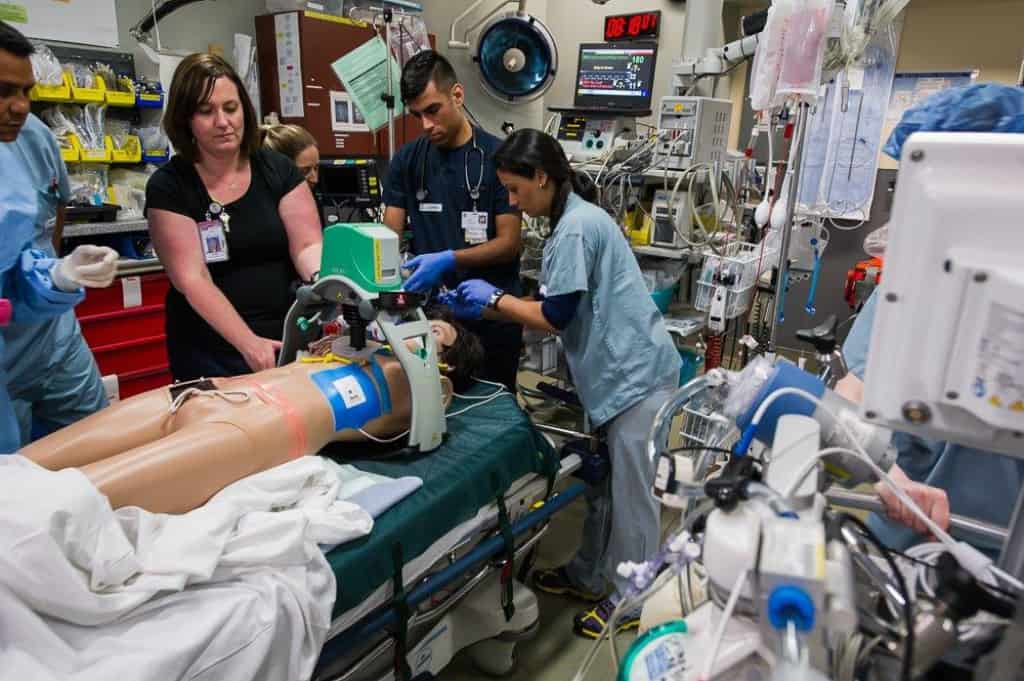Almost from the very beginning, St. Paul’s has been a teaching hospital.
By 1907, the hospital had 120 beds but only 11 nursing sisters. It was a scramble to keep up and they were desperate for help. So the Sisters boldly decided to open their own nursing school. A call went out to women over 20 years of age of “good character and in good health.” That same fall, 14 women pledged to uphold the school’s motto, “Enter to learn, go forth and do good.”
By the time the school closed in 1969, St. Paul’s School of Nursing had trained almost 4,000 nurses.
The graduates of that first class – and and the nuns and physicians who trained them – were trailblazers who set a course for over a century of teaching excellence at St. Paul’s.
Today, a long line of nurses, interns, residents, fellows, physicians, researchers, and allied health professionals stand as testaments that our innovative teaching programs do more than train the next generation: they advance the science and compassion of care.
Nurses are – and have always been – our compass
It’s fitting given the leadership and vision of the founding Sisters, that nurses are still the north star of Providence Health Care (PHC).
“Nurses are truly valued at PHC,” says Sandra Lauck, PhD, RN, and scientist. “That has translated into countless education, research, and teaching opportunities.”
Lauck also holds the St. Paul’s Hospital and Heart & Stroke Foundation Professorship in Cardiovascular Nursing at UBC. In addition to her clinical work, she is a key investigator in a number of life-changing research projects. One is looking at how nurse-led interventions can decrease hospital readmission. Another is assessing shared decision-making (when treatment decisions are made jointly with patients, their medical teams, and researchers) as a pathway to a more patient-centred approach.
In keeping with St. Paul’s long history of “paying knowledge forward,” Lauck also teaches and mentors graduate students at the UBC School of Nursing.
“Empowering nurses results in better patient care,” she says. “After all, we have more contact hours with patients than any other health care professional.”
Research illuminates the path forward
Another innovative learning program at PHC is our Practice-Based Research Challenge. Now in its 11th year, this annual competition is open to all point-of-care staff including nurses, physicians, dietitians, physiotherapists, social workers, psychologists, pharmacists…. You get the idea! The point is that everyone who engages with our patients is encouraged to bring their questions and ideas to the table.
Teams come up with small-scale research projects to answer their clinical- or care-related questions. Then, they compete with each other for funding (winning teams get $5,000) and mentors to help them carry out their research. It’s the definition of grassroots engagement – and it’s having a direct impact on patient care.
Findings from a hemophilia project are now being used in the Provincial Hemophilia Clinic at St. Paul’s to prevent and reduce bleeds and improve quality of life. A project looking into improvements for TAVI[1] care reduced post-procedure bedrest from 8 hours to the now-standard 4 hours. And a study of take-home naloxone kits (for opioid overdose) led to the engagement of youth partners, updated kits, and standardized training.
Simulation training saves lives
If you ask any healthcare provider – or airline pilot – they’ll tell you that simulation training is essential. In our Teck Emergency Centre, where seconds can make the difference between life and death, there’s a monthly ECPR simulation session: the first of its kind in Canada.
ECPR (extracorporeal cardio-pulmonary resuscitation) is a treatment protocol used for patients in cardiac arrest. It involves a team of emergency physicians and nurses, cardiologists, perfusionists, anaesthesiologists, respiratory therapists, and more. Everyone has a crucial role to play in a very confined space with a finite amount of time.
The patient is placed on an ECMO life-support machine (a heart-lung machine that circulates blood and oxygen). While the ECMO does its job, the team works to pinpoint the cause of the cardiac arrest and get the patient’s heart started again.
With the monthly ECPR simulation program, frontline staff train together in a supportive environment that encourages repetition and do-overs: two things that don’t happen during real emergencies.
How effective is it? Ask Dr. Chris Dawkins. He was rushed to the ED at St. Paul’s after collapsing on his home rowing machine. His heart had stopped. Thanks to their training, the team knew exactly what to do. And after being clinically dead for almost an hour, just one week later, Dawkins was discharged and picked up his life where he left off. With one exception, “My days on the rowing machine are over,” he says.
When you give to St. Paul’s Foundation, you support training and educational opportunities that save lives and push the limits of our abilities. This is the future of medicine and it’s happening right now, right across PHC.
Footnotes
[1] TAVI is the pioneered-at-St.-Paul’s minimally-invasive heart valve replacement procedure.
